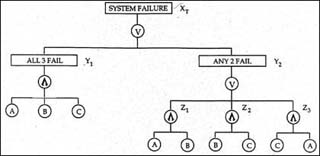
For a system with three components that fails if 2 or more components fails, the probability of overall system failure can be calculated with the help of a fault-tree. (Figure by Prof. Apostolakis.)
Instructor(s)
Prof. George Apostolakis
MIT Course Number
ESD.72 / 1.155 / 2.963 / 3.577 / 6.938 / 10.816 / 16.862 / 22.82
As Taught In
Spring 2007
Level
Graduate
Course Description
Course Features
Course Description
ERBA (ESD.72) emphasizes three methodologies - reliability and probabilistic risk assessment (RPRA), decision analysis (DA), and cost-benefit analysis (CBA). In this class, the issues of interest are: the risks associated with large engineering projects such as nuclear power reactors, the International Space Station, and critical infrastructures; the development of new products; the design of processes and operations with environmental externalities; and infrastructure renewal projects.


